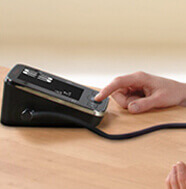
BP Resources

for successful readings

Sit quietly for 15 minutes

Wait 30 minutes after bathing, eating, exercising, drinking or smoking

Sit Correctly - Do not cross legs

Do not move or talk

Same time each day

Use the same arm/wrist
Quick step guide
Step 1:

Relax, sit down and apply the cuff.
Step 2:

Press Start/Stop button the cuff will automatically inflate.
Step 3:

Your reading will display at the end of the measurement.
Quick step guide
Step 1:

Relax, sit down and apply the cuff to the left wrist with the palm facing up.
Step 2:

Press Start/Stop button the cuff will automatically inflate.
Step 3:

Your reading will display at the end of the measurement.





WHAT CAUSES HIGH BLOOD PRESSURE?
While the cause of high blood pressure in most people remains unclear, a variety of conditions -- such as getting little or no exercise, poor diet, obesity, older age, and genetics -- can contribute to the development of hypertension.
WHAT IS SYSTOLIC AND DIASTOLIC BLOOD PRESSURE?
The blood pressure reading is measured in millimeters of mercury (mmHg) and is written as systolic pressure, the force of the blood against the artery walls as your heart beats, over diastolic pressure, the blood pressure between heartbeats. For example, a blood pressure reading is written as 120/80 mmHg, or "120 over 80". The systolic pressure is 120 and the diastolic pressure is 80.
WHAT CAN I DO TO LOWER/PREVENT HIGH BLOOD PRESSURE?
Start talking to your doctor, but people at any age can take steps each day to proactively manage their blood pressure, such as eating a healthy diet, exercising and maintaining a healthy weight, not smoking and limiting alcohol use, and monitoring your blood pressure regularly.
HOW DO I MAKE SURE MY MEASUREMENTS ARE ACCURATE?
For best accuracy, rest for a few minutes before measurement, sit upright with your feet flat on the floor, and do not talk or move during the reading. It is also important to make sure you are using the appropriate cuff size for your arm and that it is positioned according to the instructions.
HOW OFTEN DO I NEED TO CHECK MY BLOOD PRESSURE?
Routine monitoring, which is quick, easy and painless, can provide your healthcare provider with important information to determine if you have high blood pressure and, if so, what treatment plan to recommend.
What are the risk factors and variables that can put me at a greater risk for developing high blood pressure?
Risk of high blood pressure increases with age, heredity, diet and more...Understanding these risk factors can help you be more aware of how likely you are to develop high blood pressure.
WHY DO I NEED TO BE AWARE OF MY BLOOD PRESSURE?
Recently, the American Heart Association (AHA), posted new guidelines, with that, now, nearly half of American adults have high blood pressure. (Many don’t even know they have it.)
Note: A diagnosis of high blood pressure must be confirmed with a medical professional. A doctor should also evaluate any unusually low blood pressure readings.
WHAT HEALTH PROBLEMS ARE ASSOCIATED WITH HIGH BLOOD PRESSURE?
Several potentially serious health conditions are linked to high blood pressure, including:
WHY DO MY READINGS VARY?
Blood pressure is a body parameter that is subject to normal variations throughout the day. A single reading that is different from yours or your doctor’s readings are not necessarily inaccurate. The average of several readings, taken under similar conditions, using the same arm is preferred for accurate blood pressure readings.
WHY ARE MY READINGS DIFFERENT THAN THOSE TAKEN AT MY DOCTOR’S OFFICE?
Many experience a phenomenon called “White Coat Hypertension” when measured by a doctor. White Coat Hypertension refers to blood pressure that rises above its usual level when measured in a clinical setting, such as a doctor’s office.

SOURCES: